Reported Treasure Finds 2020/21 Statistical Release
Updated 2 November 2023
Applies to England, Northern Ireland and Wales
This statistical release presents data on the number of reported treasure finds for 2020 and provisional figures for 2021 within England, Wales and Northern Ireland. A treasure find is when a single or group of items is discovered which contains at least one item that may[footnote 1] meet the legal definition of treasure. Data on the type of treasure and their final destinations of the finds in 2020 are broken down by county, period, and method of discovery. Figures for 2021 are provisional and are provided by county and region only.
At the time of publication, the number of finds for 2021 has not been finalised and confirmed[footnote 2]. Therefore, the data for 2021 is provisional and it is not possible to provide a detailed breakdown of factors such as period and change in ownership in this release. As usual, this final breakdown will be provided in the Treasure Finds Statistical Release in 2023 which will cover the treasure finds for 2021 in detail and provisional figures for 2022.
Data presented on treasure finds are collected by the Department of Portable Antiquities & Treasure at the British Museum and recorded by the Portable Antiquities Scheme.
Estimates reported for participation in metal detecting are based on data collected in the 2021/22 Participation Survey.
Released – 3 November 2022
Period covered – 2020 to 2021
Geographic coverage – National, regional, and county level data for England, Wales and Northern Ireland. This release does not cover Scotland.
Next release date – November 2023
1. Headline Figures
2021
- The provisional figure for reported treasure finds in 2021 is 1,079, similar to the final 2020 figure of 1,071. It is the eighth year in a row when reported treasure finds exceeded 1,000.
- The UK region with the most finds for the 2021 provisional data was the South East of England with 265 treasure finds (25%). The UK county with the most finds for the 2021 provisional data was Norfolk with 86 treasure finds (8%).
2020
- There were 1,071 reported treasure finds in total across England, Wales, and Northern Ireland in 2020, fewer than the 2019 figure of 1,303.
- The UK region with the most finds for 2020 was the East of England with 247 treasure finds (23%). The UK county with the most finds for 2020 was Norfolk with 104 treasure finds (10%).
- Of reported treasure finds, 876 cases (82%) were object cases[footnote 3] and 195 finds (18%) were coin cases.
- Roughly a third of the found object cases (35%) and a quarter of the found coin cases (25%) were acquired by or donated to museums, totalling 304 additions to museums.
- Of the total 1,071 reported treasure finds, 1,039 (97%) of these were discovered by metal detecting.
1.1 Figure 1: Number of reported treasure finds in England, Wales and Northern Ireland, 1996-2021 (provisional)
The chart below shows the number of treasure finds each year from 1996 to 2021 (provisional), with some noteworthy benchmarks highlighted.
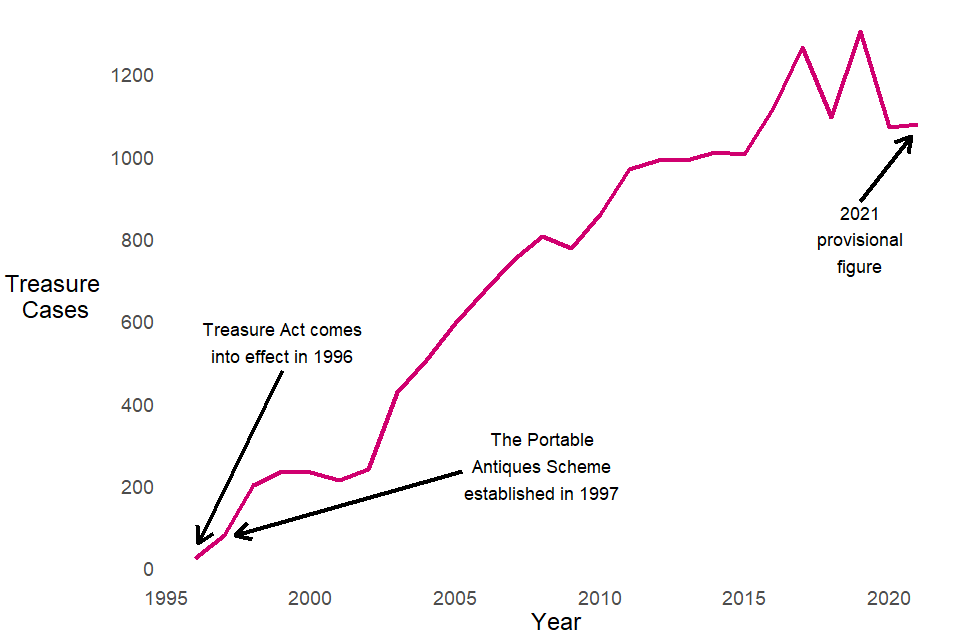
A line chart showing the number of treasure cases increased greatly from 1996 to 2021.
2. Total reported treasure finds in England, Wales and Northern Ireland in 2021 (provisional) and 2020[footnote 4]
In 2021, the provisional number of reported treasure finds was 1,079. This was greater than the final 2020 figure of 1,071. Since the Treasure Act 1996[footnote 5] replaced the old common law of Treasure Trove in England, Wales and Northern Ireland, 2021 was the eighth year in a row, and the eighth time when treasure finds exceeded 1,000.
The total treasure finds for England were 1,021 with a further 58 in Wales. There were no reported finds in Northern Ireland. It should be noted that there are additional restrictions on searching for archaeological objects in Northern Ireland, imposed by the Historic Monuments and Archaeological Objects (NI) Order of 1995.
In 2020, reported treasure finds were 1,071[footnote 6], representing a total of 31,388 artefacts (objects and coins). A ‘treasure find’ can be made of multiple artefacts, hence the total number of artefacts is much higher than the number of reported treasure finds. The total treasure finds were 1,049 for England, 22 for Wales, and 0 for Northern Ireland.
3. Reported finds by Location, 2020 (final) & 2021 (provisional)
In 2021, among regions in England, the South East of England had the highest number of reported finds at 265, followed by the East of England with 217 finds. London had the fewest reported finds with 4. The second lowest region was the North East with 13.
3.1 Figure 2: Reported treasure finds by region, 2020
In 2020, by region, the largest number of treasure finds in England, Wales, and Northern Ireland was the East of England with 247 cases (23% of total finds).
The chart below shows a geographical representation of the number of reported treasure finds in 2020 by region across England, Wales, and Northern Ireland.
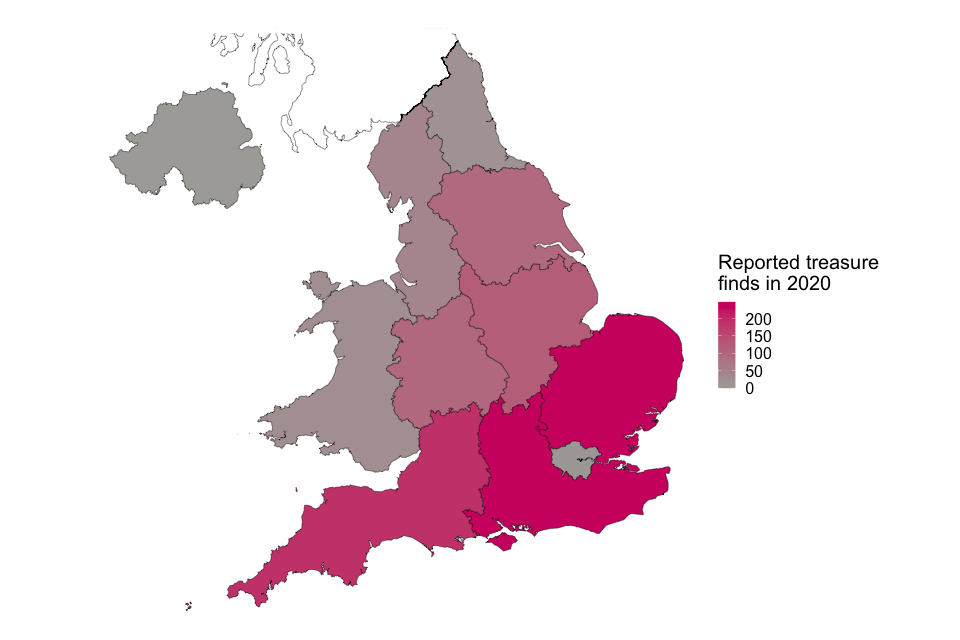
A map of the United Kingdom (not including Scotland) and how many treasure finds are made by region. The southern regions of England have more treasure finds than other regions of England, as well as Wales and Northern Ireland.
3.2 Figure 3: Reported treasure finds by region, 2020
The chart below shows the number of treasure finds by region in 2020 across England, Wales, and Northern Ireland in descending order of treasure finds.
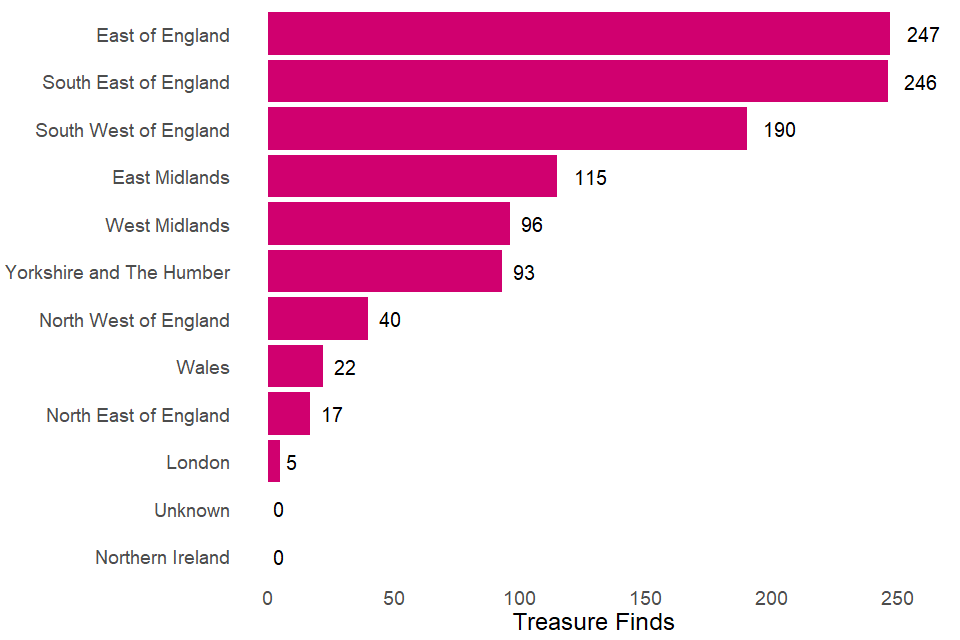
A bar chart showing the number of treasure finds by United Kingdom region. More finds are made in the southern regions of England than the northern regions of England, or Wales and Northern Ireland.
3.3 Reported Treasure finds by county, 2020 & 2021 (provisional)
In 2021, by county, the largest number of treasure finds in England, Wales and Northern Ireland was Norfolk with 86 cases (8% of total finds). Similarly in 2020, the largest number of treasure finds in England, Wales and Northern Ireland was Norfolk with 104 cases (10% of total finds).
Table 1 below shows the top 10 counties for treasure finds in England in 2020, with 2021 provisional figures included, in descending order of treasure finds in 2020.
3.4 Table 1: Reported Treasure finds by county, 2020 & 2021 (provisional)
| County | 2020 | 2021 (prov.) |
|---|---|---|
| Norfolk | 104 | 86 |
| Hampshire | 69 | 67 |
| Suffolk | 57 | 62 |
| Kent (incl. Medway) | 54 | 74 |
| Yorkshire, North (incl. York) | 54 | 59 |
| Wiltshire and Swindon | 51 | 68 |
| Essex | 50 | 34 |
| Lincolnshire | 47 | 62 |
| Oxfordshire | 42 | 44 |
| Somerset (incl. North Somerset and Bath & NE Somerset) | 42 | 25 |
4. Characteristics of reported finds in 2020
We are able to provide characteristics of the treasure finds from 2020, reporting on the object type discovered, the period of history it originates from, and the number of pieces of treasure museums in the UK were interested in acquiring. A breakdown of the data is not yet available for 2021 as, in line with usual timescales, treasure finds for 2021 had not been finalised and confirmed[footnote 2] at the time of publication. This also means that the data is still provisional and subject to change. The next statistical release (due to be published in November 2023) will cover the characteristics for the 2021 treasure finds.
There were 1,071 treasure finds reported in 2020 (876 object cases and 195 coin cases). Of these cases:
- 256 were acquired by museums (198 object cases, 58 coin cases) [footnote 7]
- 48 were donated to museums (44 object cases, 4 coin cases) allowing them to be acquired by museums at no (or reduced) public cost
- 470 were withdrawn or disclaimed[footnote 8] by museums (402 object cases, 68 coin cases)[footnote 9]
- 54 did not meet the definition for treasure (49 object cases, 5 coin cases)
- 243 are yet to be confirmed (183 object cases, 60 coin cases)
Of these finds, the three largest acquisitions were made by the Norwich Castle Museum & Art Gallery (20 cases) , the Hampshire Cultural Trust, and the Museum of Somerset (14 cases for both).
Under the Treasure Act 1996, the Secretary of State has the power to disclaim [footnote 8] a find, even when the find meets the definition of treasure under the Act. This can occur at any point in the process, for example, if a museum withdraws its interest in acquiring a find and no other museum expresses an interest.
The total number of finds which meet the definition for treasure in 2020 was 774. This includes acquired, donated, and disclaimed items.
4.1 Figure 3: Reported treasure finds, by change in ownership: England, Wales and Northern Ireland, 2020
The chart below shows the reported treasure finds and their ownership, in descending order of total cases.
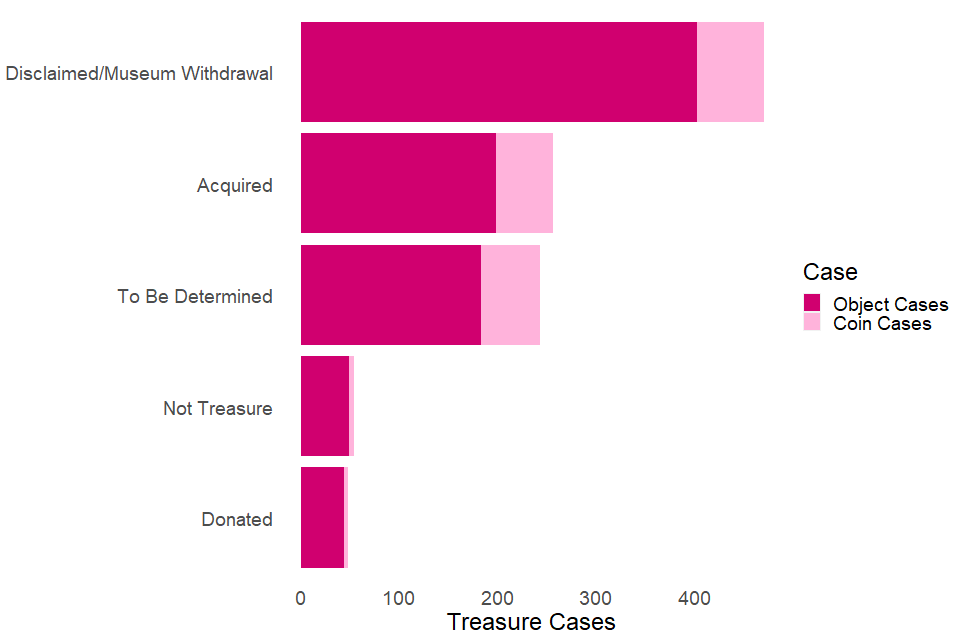
A bar chart showing the outcome of treasure finds for both object cases and coin cases. Most treasure cases are disclaimed or acquired.
Around a third (36%) of treasure cases[footnote 10] in 2020 were from the post-medieval (15th to 18th Century) period (351 object cases and 37 coin cases) and a quarter (25%) were from the medieval period (5th to 15th Century) (221 objects and 47 coin cases).
4.2 Figure 4: Reported treasure cases by period: England, Wales and Northern Ireland, 2020
The chart below shows the reported treasure finds by the time period they belong to, in descending order of total cases.
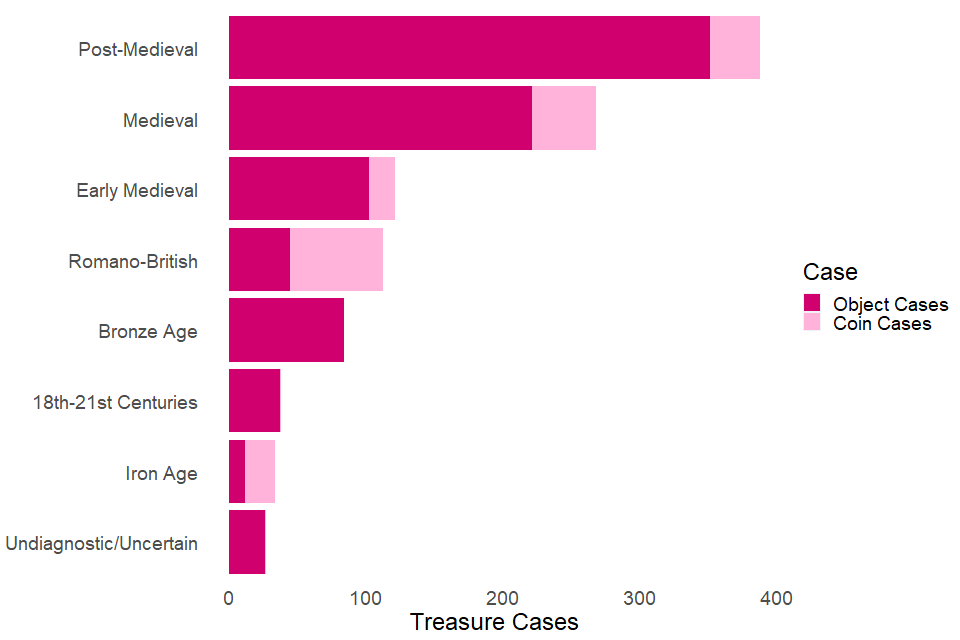
A bar chart showing the period for which treasure cases are from for both object cases and coin cases. Most finds are from the post-medieval, medieval and early medieval periods respectively.
5. Mode of discovery
The majority (97%) of treasure finds in 2020 were discovered by metal detecting, similar to the proportion in 2019. In 2020, a further 2% (21 cases) were archaeological finds and 1% (11 cases) were field walking or searching the foreshore.
In 2021/22, according to the Participation Survey, an estimated 1% of adults (aged 16 or over) in England said they had taken part in metal detecting at least once in the 12 months prior to the survey[footnote 11]. This is a similar level to participation in 2019/20. The rate varies regionally.
Footnotes
-
Even if the item is found to not be treasure at a later date the discovery is still counted as a treasure find. ↩
-
Treasure finds are considered resolved when the valuation process has been completed, the interested parties waive their right to a reward, the Crown disclaims interest in the case or a case has been deemed not treasure. ↩ ↩2
-
An object case is a find of any non-coin artefact. ↩
-
Data for Scotland is collated under the Scottish Treasure Trove system available at: https://treasuretrovescotland.co.uk/reports-and-minutes/ ↩
-
The Treasure Act 1996 replaced the common law of treasure trove in England, Wales and Northern Ireland. Scotland has a separate law of treasure trove and therefore isn’t covered in this statistical release. ↩
-
This figure has been amended from the provisional 2020 figure (1,077) reported in last year’s release as the number of finds had not yet been resolved at the time of publication. ↩
-
Acquired cases cover finds that have been acquired as well as finds where museums have made an expression of interest, but have not yet acquired. ↩
-
Disclaimed is a technical term, legally defined as a formal statement saying that you are not legally responsible for something. ↩ ↩2
-
Disclaimed/museum withdrawal cases are those cases where the Secretary of State disclaims title to the find prior to inquest because no museum is interested in acquiring the find or, following an inquest, the acquiring museum withdraws its interest. In both cases the find is returned to the finder or landowner. Title is a technical term, legally defined as the actual ownership of the property ↩
-
The figures for treasure cases include those which are to be determined and those categorised as not treasure. This is because while an object case or coin case may not be treasure, the find is still classified as a treasure case. ↩
-
Survey participants were asked whether they had participated in metal detecting within the last 12 months (at the time of the survey), therefore, these statistics are not intended to capture an estimate of ‘regular’ metal detectorists or those who are members of metal detecting clubs within England. ↩
